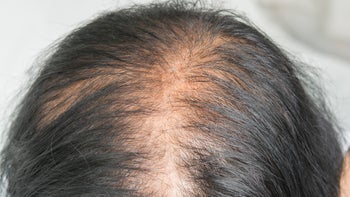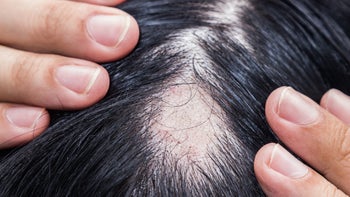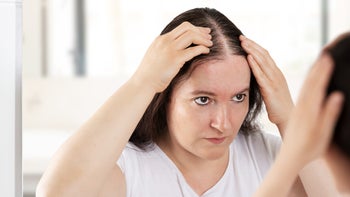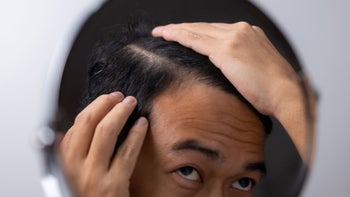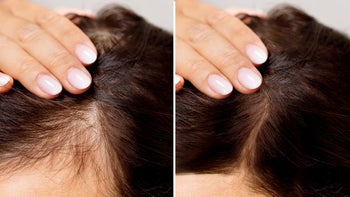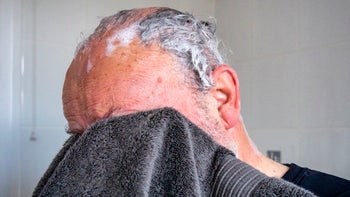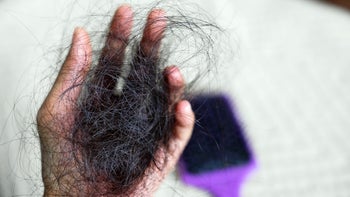
What Are the Best Supplements and Procedures for Women’s Hair Loss? 9 Options to Consider
Key takeaways:
When it comes to supplements for women’s hair loss, vitamin D and biotin may help if your levels of these vitamins are low. But they aren’t likely to make a difference otherwise. Ashwagandha may help improve hair loss caused by stress.
Fish oil (omega-3 fatty acids) and saw palmetto supplements aren’t recommended for women’s hair loss. There isn’t good evidence they’re effective, and they carry risks and side effects to consider.
Topical treatments, such as pumpkin seed oil or rosemary oil, don’t show much evidence that they help with hair loss. But they’re unlikely to cause harm if you want to give them a try.
Scalp procedures such as platelet-rich plasma injections and microneedling have been shown to improve hair growth and reduce hair loss in women. These procedures may work best in combination with other hair-loss treatments, such as minoxidil (Rogaine).
Table of contents

Women’s hair loss can happen for many different reasons. It can be genetic, due to hormonal changes, or caused by nutritional deficiencies. Women may also lose hair when taking certain medications, from health conditions such as thyroid disease, or even from stress.
No matter the cause, if you’re losing your hair it’s common to look into supplements and procedures that may help. But what are the best supplements for women’s hair loss? And do hair-loss procedures really make a difference? Here, we’ll look at what the science says about nine common supplements and procedures for women’s hair loss.
1. Vitamin D
What it is: Vitamin D is important for hair health. Without enough vitamin D, your hair growth and health may decline. You can get vitamin D through sun exposure as well as eating foods high in vitamin D. Vitamin D supplements are also available both over the counter (OTC) and with a prescription.
Stay healthy with CVS
Shop the brands you trust at CVS. Whether it’s wellness or beauty, get what you need at great prices.

What the research says: There seems to be a link between low vitamin D levels and the development of female-pattern hair loss (FPHL, androgenetic alopecia). There’s also a connection between low vitamin D levels and alopecia areata (AA), a type of autoimmune hair loss.
But even though we know low vitamin D levels are associated with hair loss, there’s not much evidence that taking vitamin D will help hair grow back. In one study, a vitamin D supplement didn’t improve FPHL on its own. But when combined with topical minoxidil (Rogaine), it worked better than minoxidil alone. And several small studies showed an improvement in AA with topical vitamin D (calcipotriene (Dovonex)).
Worth a try? Talk to your healthcare team about testing your vitamin D levels. If your levels are too low, it’s important to get them up to normal for your overall health. But it’s unclear if this will fix any damage done to your hair. If your vitamin D levels are already normal, taking extra vitamin D isn’t likely to make any difference. Keep in mind that taking too much vitamin D can be harmful and should be avoided. You can also talk to your prescriber to see if topical vitamin D is an option for you.
2. Fish oil (omega-3 fatty acids)
What it is: Fish oil is an extract that contains high levels of omega-3 fatty acids. The omega fatty acids support heart health, have anti-inflammatory effects, and support healthy skin. But they don’t seem to play a direct role in hair health.
What the research says: One small study looked at an omega-3 and -6 supplement with antioxidants for FPHL. After 6 months, the participants reported less hair loss and thicker hair. There’s also some evidence that omega-3 and -6 supplements may help improve inflammatory skin conditions that lead to hair loss in some people.
Worth a try? There isn’t much evidence that a fish oil or omega fatty acid supplement will improve hair loss. And it’s best to get omega-3s from your diet, in foods such as salmon, walnuts, and chia seeds. If you’re interested in taking a fish oil supplement, talk to your prescriber first. They’re not recommended for everyone. Fish oil side effects can include bad-smelling breath and sweat, diarrhea, and nausea.
Female-pattern hair-loss treatments: Learn which treatments are recommended for female pattern hair loss to help you choose the best fit for your needs.
Common causes of hair loss in women: Take a look at common causes of hair loss in women at different ages.
Postpartum hair loss: It’s normal to lose hair after pregnancy. Here’s why.
3. Ashwagandha
What it is: Ashwagandha is an adaptogen that’s derived from an evergreen shrub. It seems to help manage stress and anxiety. Some hair loss is linked to high stress levels (telogen effluvium). So it’s thought that ashwagandha may be beneficial in these situations.
What the research says: One small study found that topical ashwagandha improved hair growth and health in people with mild-to-moderate hair loss. But most studies on oral ashwagandha also include several other compounds, so it’s hard to narrow down its individual effect.
Worth a try? If your hair loss is primarily due to stress, an ashwagandha supplement may be worth a try. But be sure to check with your healthcare team first. Ashwagandha can interact with several medications and health conditions. Side effects can include nausea, diarrhea, and liver problems.
4. Saw palmetto
What it is: Saw palmetto is an extract from the berries of the Serenoa repens tree. It’s been found to block an enzyme that converts testosterone into dihydrotestosterone (DHT). This led to interest in taking it for hormonal hair loss caused by high DHT levels.
What the research says: One small study found that both oral and topical saw palmetto reduced hair loss and improved hair density after 16 weeks. A clinical review concluded that saw palmetto supplements may deliver modest hair regrowth. But most of the studies reviewed used other treatments along with saw palmetto or only studied its effects in men.
Worth a try? Saw palmetto seems to be well tolerated with few drug interactions. But there’s little evidence that it helps with women’s hair loss. And it may lead to birth defects if it’s taken during pregnancy. So it’s best to avoid this supplement unless your prescriber recommends it.
5. Biotin
What it is: Biotin is another name for vitamin B7. Low biotin levels are associated with thinning hair and hair loss. This has led to it being one of the top supplements people turn to for hair health.
What the research says: Most of the research on biotin for hair loss is of low quality. And a recent clinical review found that the few high quality studies available show biotin has no benefit when it comes to hair loss. However, low biotin levels are common in women with hair loss. In this case, a biotin supplement may be helpful.
Worth a try? A biotin supplement may help reduce or prevent hair loss caused by low biotin levels. But it’s unlikely to help with other causes of hair loss. That being said, many people report that it seems to make a difference, regardless of what the research says. Biotin supplements can interfere with blood tests for vitamin D, thyroid levels, and certain hormones. So it’s best to check with your prescriber before taking it.
6. Pumpkin seed oil
What it is: Pumpkin seed oil contains omega fatty acids as well as compounds that lower DHT levels.
What the research says: One small study compared topical pumpkin seed oil to minoxidil 5% in women with FPHL. Minoxidil was the more effective treatment, but pumpkin seed oil did show some benefit in improving hair growth. Most other studies on pumpkin seed oil only included men, so it’s unclear what role it may play in women's hair loss.
Worth a try? There’s little evidence that pumpkin seed oil will help with women’s hair loss. But if you want to try it as a topical treatment, it’s unlikely to cause any harm. But oral pumpkin seed oil supplements carry similar risks to fish oil and saw palmetto. So you should check with your prescriber before trying it.
7. Rosemary oil
What it is: Rosemary oil is derived from the leaves of the rosemary shrub. It’s thought to have anti-inflammatory effects and reduce stress and anxiety. It also seems to block DHT’s activity in the body.
What the research says: The available studies on topical rosemary oil for hair loss were done using male or animal subjects. So it’s not clear what role, if any, it may have for hair loss in women.
Worth a try? There’s not enough evidence to recommend applying topical rosemary oil to help with hair loss in women. But the available evidence doesn’t show any harm in trying it, other than the possibility of mild skin irritation.
8. Platelet-rich plasma injections
What it is: Platelet-rich plasma (PRP) injections work by drawing your blood and processing it to get a layer of plasma and platelets. This is then injected into your scalp. It’s thought that the growth factors in your plasma can help stimulate hair growth.
What the research says: Review studies suggest that PRP injections are an effective treatment for most types of hair loss in women. But since it isn’t FDA approved for this, there isn’t a standard dose or method for this treatment. So the results may vary depending on how the treatment is administered.
Worth a try? Based on the evidence, PRP injections are likely to improve hair loss. It’s considered a safe procedure with few side effects, and people report being satisfied with the results. However, PRP injections can be expensive, and they’re unlikely to be covered by insurance. You’ll also likely need to continue receiving periodic PRP injections in order to maintain the results. So this may not be an accessible treatment option for everyone.
9. Microneedling
What it is: Microneedling is a procedure that involves a roller with tiny needles applied to your scalp. This produces micro-injuries that seem to stimulate hair follicles, increase collagen production, and increase the penetration of topical hair loss medications.
What the research says: Microneedling seems to work well on its own. But most studies look at it combined with other treatments, such as PRP injections or minoxidil. As with PRP injections, microneedling isn’t an FDA-approved treatment for hair loss. So the needle size and frequency of treatments hasn’t been well established, which can make results inconsistent.
Worth a try? Microneedling may be a good addition to a hair loss treatment plan for women. Side effects can include scalp irritation, mild bleeding, or infection. Some people microneedle on their own at home. But it’s safer to leave it to a professional to avoid injury or infection. The cost of microneedling may be high, and it’s unlikely to be covered by insurance. If you take blood thinners, have eczema or psoriasis on your scalp, or are immunocompromised, microneedling may not be a safe option for you.
Do Nutrafol and other combination vitamins work for hair loss?
They might, but it’s important to look at the ingredients. Nutrafol is a supplement that’s promoted for hair growth. It contains a variety of ingredients, such as ashwagandha, saw palmetto, and biotin. Several studies show that it may improve hair growth and thickness as well as reduce hair loss in women. Viviscal is another multi-ingredient supplement that seems to help reduce hair loss in women.
Keep in mind that since these vitamins contain multiple ingredients, it’s best to discuss their safety with your healthcare team before trying them. In many cases, you may be able to replicate their effects by modifying your diet, which is often a more cost-effective option.
Are there prescription hair-loss treatments for women?
Yes, there are prescription treatments for women’s hair loss. Minoxidil is the only FDA-approved hair-loss treatment for women. But it’s effective when applied regularly. Other prescription medications are sometimes prescribed off-label for hair loss in women, including:
Spironolactone (Aldactone), which helps treat FPHL
Finasteride (Propecia), although this isn’t a first-choice option for women, especially if you may become pregnant while taking it
Your prescriber will recommend the best treatment for you based on the underlying cause of your hair loss. They can also let you know if it’s OK to take supplements along with your prescription.
The bottom line
When it comes to supplements for women’s hair loss, vitamin D and biotin may be helpful if you have low levels of these vitamins. But they’re unlikely to make a difference otherwise. Ashwagandha might be beneficial for stress-related hair loss, but this hasn’t been proven in clinical studies.
Fish oil (omega-3 fatty acids) and saw palmetto supplements aren’t recommended for women’s hair loss due to a lack of evidence and potential risks or side effects. Topical treatments, like pumpkin seed oil or rosemary oil, also don’t have much scientific support for improving hair loss, but they’re generally safe if you wish to try them.
Scalp procedures, such as platelet-rich plasma (PRP) injections and microneedling, have been shown to promote hair growth and reduce hair loss in women. They may be more effective when used alongside other treatments, such as minoxidil (Rogaine).
Why trust our experts?



References
Abe, M., et al. (2009). Isolation and pharmacological characterization of fatty acids from saw palmetto extract. Analytical Sciences.
Balić, A., et al. (2020). Omega-3 versus omega-6 polyunsaturated fatty acids in the prevention and treatment of inflammatory skin diseases. International Journal of Molecular Sciences.
Banihashemi, M., et al. (2016). Serum vitamin D3 level in patients with female pattern hair loss. International Journal of Trichology.
Bhat, Y. J., et al. (2017). Vitamin D level in alopecia areata. Indian Journal of Dermatology.
de Macedo, L. M., et al. (2020). Rosemary (Rosmarinus officinalis L., syn Salvia rosmarinus Spenn.) and its topical applications: A review. Plants.
English, R. S., Jr., et al. (2021). Microneedling and its use in hair loss disorders: A systematic review. Dermatology and Therapy.
Evron, E., et al. (2020). Natural hair supplement: Friend or foe? Saw palmetto, a systematic review in alopecia. Skin Appendage Disorders.
Gowda, A., et al. (2021). A systematic review examining the potential adverse effects of microneedling. Journal of Clinical and Aesthetic Dermatology.
Gupta, A. K., et al. (2022). Microneedling for hair loss. Journal of Cosmetic Dermatology.
Hassan, G. F. R., et al. (2022). Treatment with oral vitamin D alone, topical minoxidil, or combination of both in patients with female pattern hair loss: A comparative clinical and dermoscopic study. Journal of Cosmetic Dermatology.
Hetz, S. P., et al. (2022). Patient satisfaction and clinical effects of platelet-rich plasma on pattern hair loss in male and female patients. Cureus.
Ibrahim, I. M., et al. (2021). Pumpkin seed oil vs. minoxidil 5% topical foam for the treatment of female pattern hair loss: A randomized comparative trial. Journal of Cosmetic Dermatology.
Institute of Medicine (US) and National Research Council (US) Committee on the Framework for Evaluating the Safety of Dietary Supplements. (2005). Appendix K: Prototype focused monograph: Review of antiandrogenic risks of saw palmetto ingestion by women. Dietary Supplements: A Framework for Evaluating Safety. National Academies Press.
Le Floc’h, C., et al. (2015). Effect of a nutritional supplement on hair loss in women. Journal of Cosmetic Dermatology.
National Center for Complementary and Integrative Health. (2020). Saw palmetto. National Institutes of Health.
National Center for Complementary and Integrative Health. (2023). Ashwagandha. National Institutes of Health.
National Institutes of Health. (2024). Ashwagandha: Is it helpful for stress, anxiety, or sleep? Fact sheet for health professionals.
NCCIH Clinical Digest for Health Professionals. (2019). Spotlight on saw palmetto: What the science says. National Center for Complementary and Integrative Health.
Office of Dietary Supplements. (n.d.). Nutrafol. National Institutes of Health.
Office of Dietary Supplements. (n.d.). Viviscal. National Institutes of Health.
Office of Dietary Supplements. (2021). Biotin. National Institutes of Health.
Paichitrojjana, A., et al. (2022). Platelet rich plasma and its use in hair regrowth: A review. Drug Design, Development and Therapy.
Rahbardar, M. G., et al. (2020). Therapeutic effects of rosemary (Rosmarinus officinalis L.) and its active constituents on nervous system disorders. Iranian Journal of Basic Medical Sciences.
Ring, C., et al. (2022). Nutraceuticals for androgenetic alopecia. Journal of Clinical and Aesthetic Dermatology.
Rubaian, N. F. B., et al. (2024). An overview of commonly used natural alternatives for the treatment of androgenetic alopecia, with special emphasis on rosemary oil. Clinical, Cosmetic and Investigational Dermatology.
Saini, K., et al. (2021). Role of vitamin D in hair loss: A short review. Journal of Cosmetic Dermatology.
Shaban, A., et al. (2017). Pumpkin seed oil: An alternative medicine. International Journal of Pharmacognosy and Phytochemical Research.
Sivamani, R. K., et al. (2024). A prospective, multi-center study to evaluate the safety and efficacy of a vegan nutraceutical to improve hair growth and quality in females following a plant-based diet. Journal of Drugs in Dermatology.
Sudeep, H. V., et al. (2023). Oral and topical administration of a standardized saw palmetto oil reduces hair fall and improves the hair growth in androgenetic alopecia subjects – a 16-week randomized, placebo-controlled study. Clinical, Cosmetic and Investigational Dermatology.
Trüeb, R. M. (2016). Serum biotin levels in women complaining of hair loss. International Journal of Trichology.
Ufomadu, P., et al. (2023). Complementary and alternative supplements: a review of dermatologic effectiveness for androgenetic alopecia. Baylor University Medical Center Proceedings.
Walth, C. B., et al. (2018). Response to: “Rethinking biotin therapy for hair, nail, and skin disorders.” Journal of the American Academy of Dermatology.
Yelich, A., et al. (2024). Biotin for hair loss: Teasing out the evidence. Journal of Clinical and Aesthetic Dermatology.
Yerram, C., et al. (2023). Effects of Withania somnifera root extract serum application on hair health in healthy adults: A prospective, double-blind, randomized, parallel, placebo-controlled study. Journal of Ayurveda and Integrative Medicine.
Zhang, F., et al. (2024). Observing the clinical efficacy of combined serum microneedle therapy for moderate to severe androgenetic alopecia in scalp repair. Skin Research & Technology.




